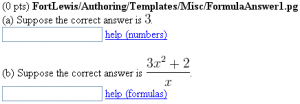FormulaAnswer1: Difference between revisions
Jump to navigation
Jump to search
mNo edit summary |
(add historical tag and give links to newer problems.) |
||
| Line 1: | Line 1: | ||
{{historical}} | |||
<p style="font-size: 120%;font-weight:bold">This problem has been replaced with [https://openwebwork.github.io/pg-docs/sample-problems/Misc/FormulaAnswer.html a newer version of this problem]</p> | |||
<h2>Answer is a Number or a Formula - [https://testcourses.webwork.maa.org/webwork2/Problem_Authoring_Techniques/T-PP-misc/1 Try it out]</h2> | <h2>Answer is a Number or a Formula - [https://testcourses.webwork.maa.org/webwork2/Problem_Authoring_Techniques/T-PP-misc/1 Try it out]</h2> | ||
Latest revision as of 11:15, 17 July 2023
This problem has been replaced with a newer version of this problem
Answer is a Number or a Formula - Try it out

This PG code shows how to write a question whose answer is a number or a formula.
- PGML location in OPL: FortLewis/Authoring/Templates/Misc/FormulaAnswer1_PGML.pg
| PG problem file | Explanation |
|---|---|
|
Problem tagging: |
|
DOCUMENT();
loadMacros('PGstandard.pl','MathObjects.pl','PGML.pl','PGcourse.pl');
TEXT(beginproblem());
|
Initialization: |
Context('Numeric');
$a = non_zero_random(-9,9,1);
do { $b = random(2,9,1); } until ( $b != $a );
$answer1 = Compute("$a");
$answer2 = Compute("$a x^($b) + $b")->reduce();
|
Setup:
We use |
BEGIN_PGML
Enter [`[$answer1]`]: [____]{$answer1} [@ helpLink('number') @]*
Enter [`[$answer2]`]: [____]{$answer2} [@ helpLink('formula') @]*
END_PGML
|
Main Text:
|
BEGIN_PGML_SOLUTION Solution explanation goes here. END_PGML_SOLUTION ENDDOCUMENT(); |
Solution: |